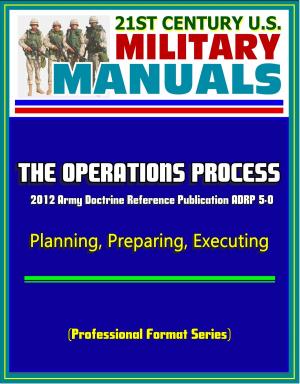Operational Initiative in Theory and Army Doctrine: Military Theory, Individual Initiative and Control to Achieve Objectives, Role of Positive Aim, Anticipation, and Relative Freedom of Action
Nonfiction, History, Military, Strategy, United States| Author: | Progressive Management | ISBN: | 9781370896936 |
| Publisher: | Progressive Management | Publication: | February 19, 2017 |
| Imprint: | Smashwords Edition | Language: | English |
| Author: | Progressive Management |
| ISBN: | 9781370896936 |
| Publisher: | Progressive Management |
| Publication: | February 19, 2017 |
| Imprint: | Smashwords Edition |
| Language: | English |
This excellent report has been professionally converted for accurate flowing-text e-book format reproduction. Every soldier wants the initiative, but few can define what that really means. What is the initiative and how can it be seized and retained? Despite its prominence in centuries of military theory and role as a foundational attribute of the US Army operating concept since 1982, the definition of operational initiative remains vague. Furthermore, the lack of clarity on this topic blurs the lines between operational initiative and individual initiative, or the willingness of individuals to act in a given situation. A clear definition of operational initiative is necessary to prevent this critical concept from devolving to a trite military cliche.
An analysis of dominant military theory and US Army doctrine reveals that initiative is a persistent phenomenon of warfare in which one belligerent holds and presses an advantage against the other. Operational initiative is therefore a form of control over adversaries and the environment, generated by pursuit of a positive aim, anticipation of future conditions, and relative freedom of action. This definition is clear, succinct, and consistent with the concept's use in military theory and throughout the history of US Army doctrine.
In chess, initiative is a dynamic advantage that belongs to the players who can force opponents to respond to their threats. By its nature, initiative requires the continuance of the attack and the spirit of the offensive. A player can seize initiative from an opponent by ignoring a threat and sacrificing a piece, or taking advantage of an opportunity when the opponent fails to make an adequate threat. The relative value of sacrifice to advantage is clear without tactical or strategic moral ramifications. No pawn weeps for the loss of its queen. Initiative is a mutually exclusive property derived from the turn-based closed-system structure of chess and is relatively easy to identify.
In war, initiative is far more complex. Turns are relative to the tempo of the belligerents. The fog of war obscures the locations, capabilities, and readiness of forces, and, occasionally, chance or the moral force of will overcomes the expected outcomes given by rules and maxims. Objectively strong militaries armed with the best equipment and training appear to struggle to find strategic advantage against poorly armed ideological insurgents. Increasing numbers of civilians, government agencies, criminal networks, and insurgent groups complicate the modern battlefield. Initiative appears to be an elusive property that is difficult to define.
This excellent report has been professionally converted for accurate flowing-text e-book format reproduction. Every soldier wants the initiative, but few can define what that really means. What is the initiative and how can it be seized and retained? Despite its prominence in centuries of military theory and role as a foundational attribute of the US Army operating concept since 1982, the definition of operational initiative remains vague. Furthermore, the lack of clarity on this topic blurs the lines between operational initiative and individual initiative, or the willingness of individuals to act in a given situation. A clear definition of operational initiative is necessary to prevent this critical concept from devolving to a trite military cliche.
An analysis of dominant military theory and US Army doctrine reveals that initiative is a persistent phenomenon of warfare in which one belligerent holds and presses an advantage against the other. Operational initiative is therefore a form of control over adversaries and the environment, generated by pursuit of a positive aim, anticipation of future conditions, and relative freedom of action. This definition is clear, succinct, and consistent with the concept's use in military theory and throughout the history of US Army doctrine.
In chess, initiative is a dynamic advantage that belongs to the players who can force opponents to respond to their threats. By its nature, initiative requires the continuance of the attack and the spirit of the offensive. A player can seize initiative from an opponent by ignoring a threat and sacrificing a piece, or taking advantage of an opportunity when the opponent fails to make an adequate threat. The relative value of sacrifice to advantage is clear without tactical or strategic moral ramifications. No pawn weeps for the loss of its queen. Initiative is a mutually exclusive property derived from the turn-based closed-system structure of chess and is relatively easy to identify.
In war, initiative is far more complex. Turns are relative to the tempo of the belligerents. The fog of war obscures the locations, capabilities, and readiness of forces, and, occasionally, chance or the moral force of will overcomes the expected outcomes given by rules and maxims. Objectively strong militaries armed with the best equipment and training appear to struggle to find strategic advantage against poorly armed ideological insurgents. Increasing numbers of civilians, government agencies, criminal networks, and insurgent groups complicate the modern battlefield. Initiative appears to be an elusive property that is difficult to define.















